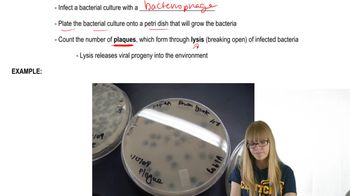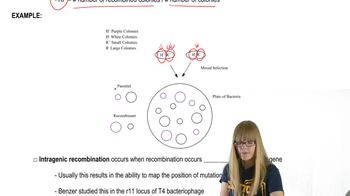Table of contents
- 1. Introduction to Genetics51m
- 2. Mendel's Laws of Inheritance3h 37m
- 3. Extensions to Mendelian Inheritance2h 41m
- 4. Genetic Mapping and Linkage2h 28m
- 5. Genetics of Bacteria and Viruses1h 21m
- 6. Chromosomal Variation1h 48m
- 7. DNA and Chromosome Structure56m
- 8. DNA Replication1h 10m
- 9. Mitosis and Meiosis1h 34m
- 10. Transcription1h 0m
- 11. Translation58m
- 12. Gene Regulation in Prokaryotes1h 19m
- 13. Gene Regulation in Eukaryotes44m
- 14. Genetic Control of Development44m
- 15. Genomes and Genomics1h 50m
- 16. Transposable Elements47m
- 17. Mutation, Repair, and Recombination1h 6m
- 18. Molecular Genetic Tools19m
- 19. Cancer Genetics29m
- 20. Quantitative Genetics1h 26m
- 21. Population Genetics50m
- 22. Evolutionary Genetics29m
5. Genetics of Bacteria and Viruses
Bacteriophage Genetics
Problem 1b
Textbook Question
In this chapter, we have focused on genetic systems present in bacteria and on the viruses that use bacteria as hosts (bacteriophages). In particular, we discussed mechanisms by which bacteria and their phages undergo genetic recombination, which allows geneticists to map bacterial and bacteriophage chromosomes. In the process, we found many opportunities to consider how this information was acquired. From the explanations given in the chapter, what answers would you propose to the following questions? How do we know that intergenic exchange occurs in bacteriophages?
 Verified step by step guidance
Verified step by step guidance1
Understand the concept of intergenic exchange: Intergenic exchange in bacteriophages refers to the recombination of genetic material between different genes, which can result in new combinations of genetic traits.
Review experimental evidence: Scientists have conducted experiments using bacteriophages, such as the classic experiments by Hershey and Rotman, which demonstrated recombination between phage genes by observing the phenotypic changes in progeny phages.
Analyze genetic mapping data: Geneticists use recombination frequencies to map the relative positions of genes on a chromosome. In bacteriophages, the occurrence of recombination events between genes can be detected by changes in the genetic map.
Consider the role of co-infection: When two different bacteriophages infect the same bacterial cell, their genetic material can undergo recombination, leading to intergenic exchange. This is often observed in laboratory settings where mixed infections are used to study recombination.
Evaluate molecular techniques: Modern molecular techniques, such as sequencing and molecular markers, provide direct evidence of intergenic exchange by allowing scientists to identify and track specific genetic changes at the DNA level.
Recommended similar problem, with video answer:
 Verified Solution
Verified SolutionThis video solution was recommended by our tutors as helpful for the problem above
Video duration:
1mPlay a video:
Was this helpful?
Key Concepts
Here are the essential concepts you must grasp in order to answer the question correctly.
Intergenic Exchange
Intergenic exchange refers to the transfer of genetic material between different genes, which can occur through processes such as recombination. In bacteriophages, this exchange can lead to the incorporation of genetic information from one phage into another, allowing for genetic diversity and adaptation. Understanding this concept is crucial for analyzing how bacteriophages can acquire new traits and influence bacterial populations.
Recommended video:
Guided course

Conjugation Overview
Genetic Recombination
Genetic recombination is a process where genetic material is rearranged during cell division or viral replication, resulting in new combinations of genes. In bacteriophages, recombination can occur through mechanisms like homologous recombination or transduction, where DNA from one bacterium is transferred to another via a phage. This process is essential for understanding how genetic variation is generated in bacterial populations.
Recommended video:
Guided course

Recombination after Double Strand Breaks
Mapping Chromosomes
Mapping chromosomes involves determining the relative positions of genes on a chromosome, which can be achieved through techniques such as recombination frequency analysis. In the context of bacteriophages and bacteria, mapping helps geneticists understand the organization of genetic material and the relationships between different genes. This knowledge is vital for studying genetic interactions and the evolutionary dynamics of microbial populations.
Recommended video:
Guided course

Mapping with Markers

 3:44m
3:44mWatch next
Master Plaques and Experiments with a bite sized video explanation from Kylia Goodner
Start learningRelated Videos
Related Practice



